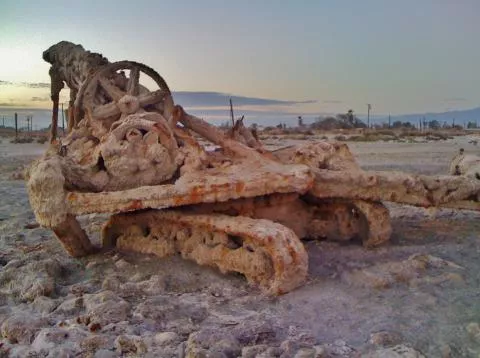Grand Schemes and Broken Dreams: Stunning Visual Remnants from Southern California's Past
Presented by Robert Larson
Tuesday, May 5, 2015, 7:30 PM
San Bernardino County Museum, 2024 Orange Tree Lane, Redlands Robert Larson will present at the May 5 San Gorgonio Chapter meeting. His talk, illustrated with his own photographs, is titled Grand Schemes and Broken Dreams: Stunning Visual Remnants from Southern California's Past.
Robert’s history presentation features the Salton Sea, the Goat Canyon Railroad Trestle and the Bridge to Nowhere, why they are there, what they were intended to become and what they are today. He will show how all three, in different ways, are related to water and Southern California water management.
The Salton Sea was created by accident starting in 1905 when hastily constructed connectors to the All American Canal were overcome by high waters in the Colorado River. Over a period of two years, the entire river flow was diverted into the Salton Sink, creasing the lake 200 feet below sea level. By the 1950s, a thriving introduced fishery supported recreational fishing and resorts, marinas and yacht harbors dotted the lakeshore. Later, an increase in the lake level flooded the developments and obnoxious fish die offs drove the recreation industry away. Larson says, “Since the late 1970s, the Salton Sea has mostly sported a surreal post-apocalyptic look and feel with rotting, rusting, crumbling, half-flooded buildings.”
In 1907, sugar baron John Spreckles broke ground on the San Diego and Arizona Railroad, secretly funded by the Southern Pacific. Dubbed the “Impossible Railroad,” it connected San Diego to the east while bypassing Los Angeles. Plagued by wash outs and tunnel collapses, it was eventually abandoned, but not before the construction of the Goat Canyon Railroad Trestle, claimed to be the longest curved railroad trestle in the world.
Many San Gorgonio Chapter members are familiar with the Bridge to Nowhere. It’s been the destination of many of our hikes over the years. It’s a beautiful arched concrete span over the East Fork of the San Gabriel River. During the Great Depression, a highway was under construction to connect Azusa across the San Gabriel Mountains to Wrightwood. The 50-year flood of March 1938 washed out the East Fork Road and forever isolated the bridge, which is now in the Sheep Mountain Wilderness.
Robert Larson is a southern California native with a lifelong interest in the local deserts and their lore. Robert has worked as a free-lance writer and radio talk show host. He loves backpacking to remote locations to explore some of California's odd hidden gems.
Robert's work has been published in the Temecula Valley Museum's The High Country, Fate magazine, Art Bell's After Dark, and The Excluded Middle. He also contributed an entry to the book Weird California: Your Travel Guide to California's Local Legends and Best Kept Secrets.
From 2005 to 2012, Mr. Larson hosted a weekly radio program called Out The Rabbit Hole at KUCI Radio at the University of California at Irvine. This involved indepth interviews with various guests - usually book authors - on a variety of topics ranging from the socio-political to the paranormal to the historical to the folkloric to the arts. He currently is a correspondent for the Heather McCoy Show - also at KUCI - reporting news from the Inland Empire.
